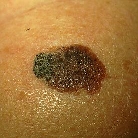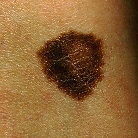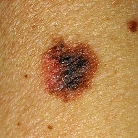AMERISKIN ® Dermatology
www.ameriskin.com
"Bringing Personalized Skin Care to the People of America"
| Home | About Us | Melanoma | Squamous Cell Cancer | Basal Cell Cancer | Pre-Cancers |
| Skin Screening | Notification | Consent | Database | Referrals | Links |
Melanoma: Prevention, diagnosis and treatment
The American Cancer Society and Centers for Disease Control estimates nearly 93,000 new cases of malignant melanoma diagnosed will be diagnosed in 2018.

Melanomas are very dangerous skin cancers. Approximately five percent (5%) of all skin malignancies are melanomas. Melanoma may spread (metastasize) to other areas of the body, if not detected early, and may eventually kill.



Images from left to right: Benign mole, Dysplastic mole, Malignant
melanoma
The ABCDE method (see photos above) may help detect melanoma: A (most early melanomas are asymmetrical); B (borders of melanomas are uneven); C (color; varied shades of brown, tan, or black are often the first sign of melanoma); and D (diameter; early melanomas tend to grow larger than common moles, greater than 6 mm in diameter), E (elevation or enlargement, areas of melanoma may be elevated above the level of the adjacent skin and appear as small nodules, itch, ulcerate, or bleed).
The major risk factors for developing cutaneous melanoma are (in order of decreasing importance): (1) a new mole or pre-existing mole that has changed or is changing, (2) dysplastic moles with a prior personal history of melanoma and familial melanoma history, (3) dysplastic moles, and (4) large congenital moles. Melanoma may develop “de novo” in 15% of cases from apparently “normal skin”. People with a history of “blistering” sunburns should be closely examined throughout life for melanomas.Each year, malignant melanoma kills about 100,000 people worldwide. Routine self examination of one’s skin is a very important component of early diagnosis of melanoma.
AMERISKIN ® Dermatology is a public-private effort
in healthcare services related to educating Americans about proper skin care
as well as the prevention, diagnosis and treatment of skin conditions, including
skin cancers. If you undergo a skin biopsy, the skin specimen may be sent
to AMERISKIN ® Dermatology for processing, evaluation, diagnosis,
and inclusion in its database.
For more information about our services or to send skin biopsies to us, contact
AMERISKIN ® Dermatology
Byron L. Barksdale, M.D.
© Copyright, 2003-2023 All rights reserved worldwide.
